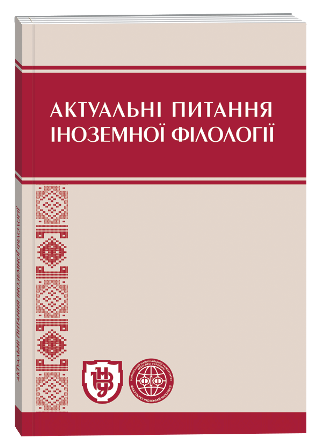LINGUO-DISCURSIVE MODEL OF TOXIC POLITICAL COMMUNICATION IN THE MEDIA ENVIRONMENT OF THE UNITED STATES, GREAT BRITAIN AND UKRAINE
DOI:
https://doi.org/10.32782/2410-0927-2021-14-20Keywords:
linguo-discursive, model, toxic, political communication, verbal, non-verbal, extralingual, the United States, Great Britain, Ukraine, media environment, contrastAbstract
The article attempts to build a linguo-discursive model of toxic political communication and determine discursive contrasts in the media environment of the United States, Great Britain and Ukraine. Toxic political communication is a type of interaction characterized by a high degree of aggressive (verbal and/or non-verbal) behavior of different participants in political discourse, which causes moral damage or discriminates against the opponent based on race, nationality or gender resulting in such politician(s) being perceived and then defined as toxic. Within the addresser-addressee chain the toxic political communication model takes into account the mechanisms of discursive expression of toxicity (toxic utterance/action/gesture), modes of spreading toxic effects (direct, indirect, mediated), mechanisms of perception and formation of the image of politicians in media (toxic vs. positive). Verbal forms of expressing toxicity include racist, nationalist, xenophobic, sexist and other discriminatory statements that degrade the personality of a political opponent and cause him or her psychological harm and/or damage their image. Non-verbal forms of expressing toxicity are divided into prosodic and gestural-mimic forms, which include aggressive, caustic, humiliatingly paternalistic, snobbish tone of speech, gestures that violate the personal boundaries of the interlocutor, exaggerated facial expressions. Extralingual forms include colors, symbols, clothing, location, selection of music etc., which exacerbate the damaging effect of the actions/statements of a politician who is labelled as toxic in the media. The discursive contrasts of toxic political communication in the media environment of the United States, Great Britain and Ukraine are determined by informational events relevant to each country, such as RACISM & INTOLERANCE TOWARDS IMMIGRANTS (the USA), PARTYGATE (the UK), ZRADA/TREASON (Ukraine) etc. Common to the three discourses is the aggressive-emotional type of a toxic politician, whose statements/messages are characterized by causing psychological damage to the opponent through direct discrediting or indirect moral damage to absent third parties/society.
References
Ковалевська А. В. Нейтралізація патогенних дискурсів: стратегія спростування. Наукові записки Вінницького державного педагогічного університету імені Михайла Коцюбинського. Серія: Філологія. 2020. Випуск 31. С. 132–141. DOI: 10.24919/2308-4863/34-2-24
Москвин Д. Визуальные репрезентации в политике и перспективы визуальных методов исследований в политической науке. Символическая политика. 2012. 1. С. 81–84.
Сальникова Е. В. Феномен визуальности и эволюция визуальной культуры : дис. ... доктора культурологических наук: 24.00.01 / Сальникова Екатерина Викторовна. Москва, 2012. 675 с.
Шкворченко Н. Токсичные информационные контенты в политической коммуникации США, Великобритании и Украины. Knowledge, Education, Law, Management. 2021. 3 (39) 2. P. 121–126.
Шкворченко Н. М. Токсичний політичний дискурс у США й Україні: когнітивно-дискурсивні контрасти. Записки з романо-германської філології. 2021. Випуск 1 (46). С. 127–134.
Шкворченко Н. Н. Токсичные вербальне контенты в политических дискурсах США, Великобритании и Украины. Proceedings of the 11th International scientific and practical conference. Perfect Publishing. Toronto, Canada. 2021. P. 436–440.
Brinkmann S. Persons and Their Minds: Towards an Integrative Theory of the Mediated Mind. NY : Routledge, 2017. 140 p.
Coleman P. T. The Way Out: How to Overcome Toxic Polarization. NewYork, NY : Columbia University Press. 2021. 296 p.
Dorrian M. Writing of the image: architecture, the city and the politics of representation. London, England : I. B. Tauris, 2019. 266 p.
Glass L. Toxic People: Toxic People: 10 Ways Of Dealing With People Who Make Your Life Miserable. NY : Simon & Schuster, 1995. 288 p.
Liboiron М., Tironi М. & Calvillo N. Toxicpolitics: Actingin a permanently polluted world. Social Studies of Science. 2018. Vol. 48 (3). P. 331–349. DOI: 10.1177/0306312718783087
Pavlíková M., Šenkýřová B., Drmola J. Propagandaa nd Disinformation Go Online. Challenging Online Propaganda and Disinformation in the 21st Century. Cham : Springer International Publishing, 2021. 273 p.
Shkvorchenko N., Cherniaieva I., & Petlyuchenko N. Linguistic approaches and modern communication technologies in political discourses in Europe and the USA (contrastive aspect). Cuestiones Políticas. 2021. 39 (70), 821–837. URL: https://doi.org/10.46398/cuestpol.3970.49
Steffan D. Visual politics: investigating the visual communication strategies of political parties and candidates from a longitudinal and comparative perspective. Baden-Baden : Nomos, 2021. 116 p.
Tirrell L. ToxicSpeech: TowardanEpidemiologyofDiscursive Harm. PhilosophicalTopics. 2017. 45 (2). P. 139–161.







